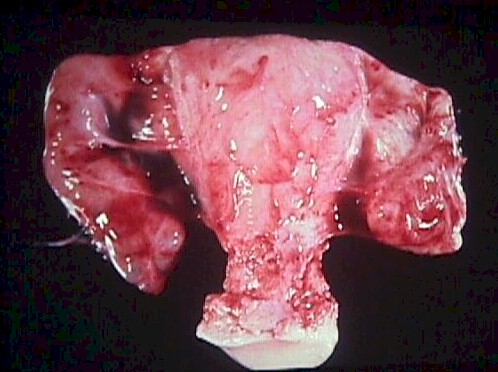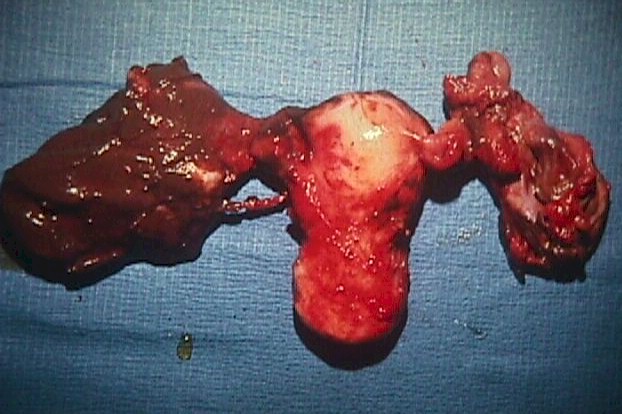Pelvic Inflammatory
Disease (PID)
Pelvic Inflammatory Disease (PID) is a bacterial
inflammation of the fallopian tubes, ovaries, uterus and cervix.
 Initial
infections are caused by single-agent STDs, such as gonorrhea or chlamydia. Subsequent infections
are often caused by multiple non-STD organisms (E. Coli, Bacteroides,
etc.). Responsible organisms include STDs, normal vaginal inhabitants,
and enteric bacteria. Initial
infections are caused by single-agent STDs, such as gonorrhea or chlamydia. Subsequent infections
are often caused by multiple non-STD organisms (E. Coli, Bacteroides,
etc.). Responsible organisms include STDs, normal vaginal inhabitants,
and enteric bacteria.
Most cases of PID have no long-term adverse effects, but some have
such serious (or disastrous) consequences as infertility, tubo-ovarian
abscess, and sepsis. Women with a history of PID are at increased risk
for subsequent tubal ectopic pregnancy.
Symptoms of PID vary from nearly trivial pelvic discomfort and
vaginal discharge to incapacitating abdominal pain with nausea and
vomiting. Leukocytosis, like fever, is
variable in cases of PID. The diagnosis can be based on such imprecise
findings as uterine and adnexal tenderness without other explanation, or
such precise findings as laparoscopic visualization of inflamed tubes
with surrounding purulence. Cervical cultures may or
may not be positive. Ultrasound findings may be normal or may include a
generalized haziness due to edema. In more advanced cases, hydrosalpinx
may be seen with ultrasound, CT or MRI.
From a clinical management point of view, there are
two forms of PID:
- Mild, and
- Moderate to Severe
Mild PID
Gradual onset of mild bilateral pelvic pain with purulent
vaginal discharge is the typical complaint. Fever <100.4 and deep
dyspareunia are common.
Moderate pain on motion of the cervix and uterus with
purulent or mucopurulent cervical discharge is found on examination. Gram-negative diplococci or
positive chlamydia culture may or
may not be present. WBC may be minimally elevated or normal.
These cases are treated aggressively, but usually with oral medications.
Prompt response is expected. Sexual partners should also be treated.
Oral treatment may consist of
Ofloxacin400 mg
orally twice a day for 14 days
OR
Levofloxacin500 mg
orally once daily for 14 days
WITH or WITHOUT
Metronidazole 500 mg orally twice a day for 14 days.
Another primarily oral regimen is:
Ceftriaxone250
mg IM in a single dose
OR
Cefoxitin2 g IM in a
single dose and Probenecid, 1 g orally administered concurrently in a single dose
OR
Other parenteral third-generation cephalosporin (e.g., ceftizoximeor cefotaxime)
PLUS
Doxycycline 100 mg orally twice a day for 14 days
WITH or WITHOUT
Metronidazole 500 mg orally twice a day for 14 days.
For further information, read the CDC Treatment Guidelines for PID
 Moderate
to Severe PID Moderate
to Severe PID
With moderate to severe PID, there is a gradual onset of moderate to
severe bilateral pelvic pain with purulent vaginal discharge, fever
>100.4 (38.0), lassitude, and headache. Symptoms more often occur
shortly after the onset or completion of menses.
Excruciating pain on movement of the cervix and uterus
is characteristic of this condition. Hypoactive bowel sounds, purulent
cervical discharge, and abdominal dissension are often present. Pelvic
and abdominal tenderness is always bilateral except in the presence of
an IUD.
Gram-negative diplococci in cervical discharge or
positive chlamydia culture may or may not be present. WBC and ESR are
elevated.
These more serious infections require more aggressive management,
often consisting of bedrest, IV fluids, IV antibiotics,
and NG suction if ileus is present. A more gradual recovery is expected
and it may be several weeks before the patient is feeling normal.
ANTIBIOTIC REGIMEN: (Center for Disease Control, 2002)
Cefotetan2 g IV
every 12 hours
OR
Cefoxitin2 g IV every
6 hours
PLUS
Doxycycline 100 mg orally or IV every 12 hours.
The doxycycline is continued for 14 days. The parenteral medication
may be stopped 24 hours after clinical improvement.
OTHER ALTERNATIVE ANTIBIOTIC REGIMENS: (Center for
Disease Control, 2002)
Clindamycin900
mg IV every 8 hours
PLUS
Gentamicinloading dose IV or IM (2 mg/kg of body
weight) followed by a maintenance dose (1.5 mg/kg) every 8
hours. Single daily dosing may be substituted.
Ofloxacin400 mg
IV every 12 hours
OR
Levofloxacin500 mg
IV once daily
WITH or WITHOUT
Metronidazole 500 mg IV every 8 hours
Ampicillin/Sulbactam 3 g IV every 6 hours
PLUS
Doxycycline 100 mg orally or IV every 12 hours.
For further information, read the CDC Treatment Guidelines for PID
Military Applications
PID is a relatively common occurrence in the military population and the
advanced settings in which they operate. It is prudent to consider PID whenever
presented with a patient complaining of pelvic pain or an unusual vaginal
discharge.
In conventional settings, cultures can be very helpful in determining who
needs treatment and who doesn't. In forward military settings, treatment must
often be based on your clinical suspicions, patient history and operational
circumstances. Liberal use of these antibiotics is encouraged.
The problem with moderate to severe PID in a forward setting is that even
when things go well, it usually requires prolonged IV antibiotic therapy (weeks)
to achieve a cure, and a lengthy recovery (4-6 weeks). When things don't go
well, surgical intervention to remove pelvic abscesses is usually required. For
these reasons, mild PID is usually treated effectively in the advanced setting,
while MEDEVAC is employed for
those with moderate to severe PID. A significant fever is characteristic of the
moderate to severe PID group. |




